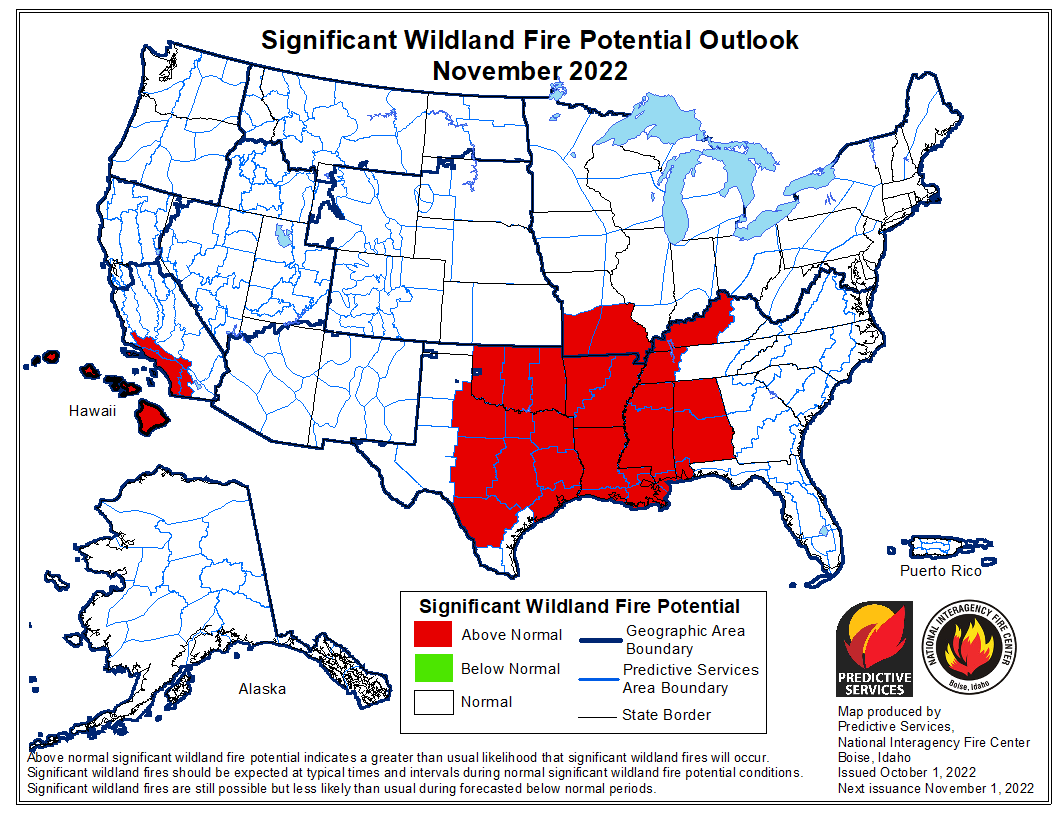
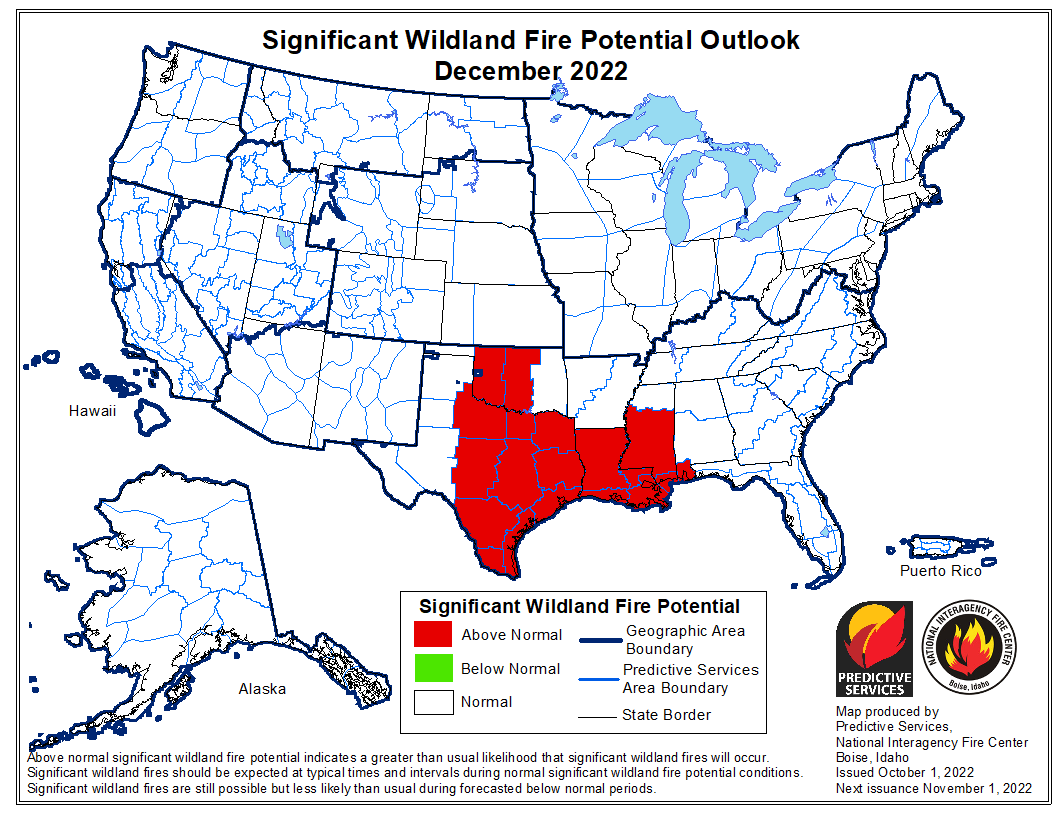
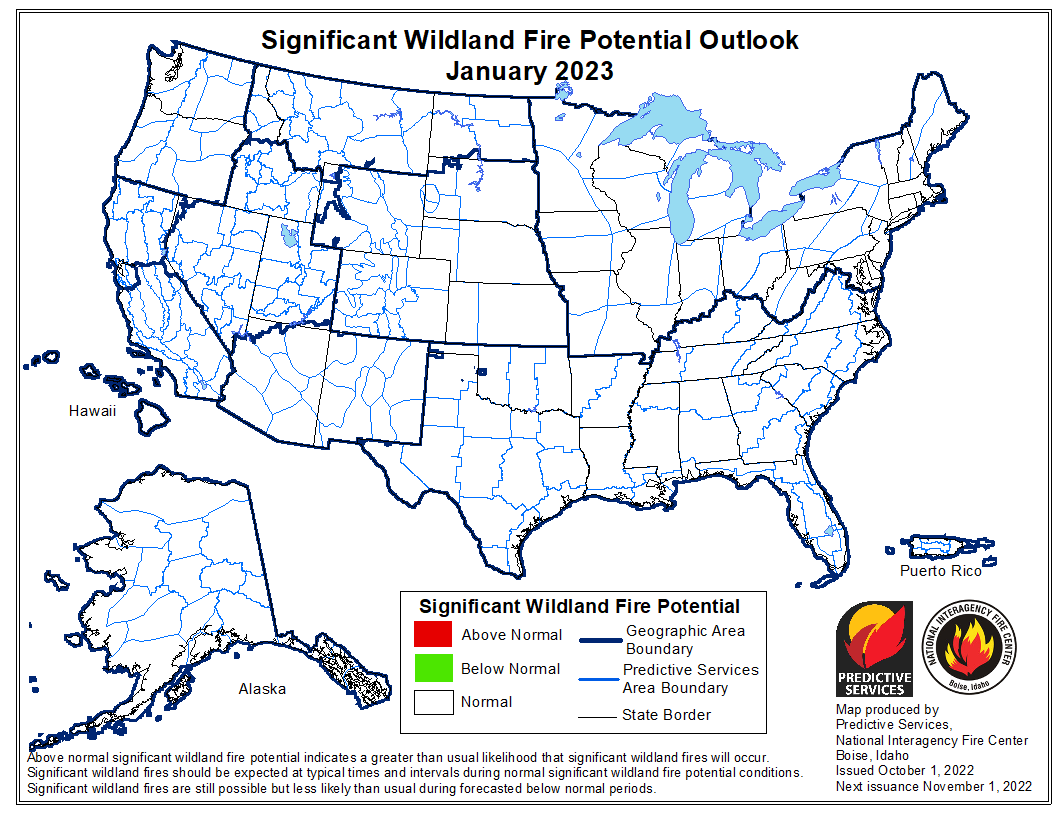
Figure: The National Significant Wildland Fire Potential Outlook identifies areas with above, below, and near normal significant fire potential using the most recent weather, climate, and fuels data available. These outlooks are designed to inform decision makers for proactive wildland fire management.
Year-to-date acres burned for the US is approximately 108% of the 10-year average, with an above average number of fires as well. Above normal significant wildland fire potential is forecast for much of Oklahoma, Texas, the Lower Mississippi Valley, and central Gulf Coast into December. Above normal potential is likely for the western Ohio Valley through the Ozarks into November. The Transverse and Peninsular Ranges of southern California to the coast, areas prone to Santa Ana winds, will have above normal significant potential into November, before returning to normal potential in December. The Hawai’ian Islands will continue to have above normal potential, especially lee sides, through November before returning to normal potential in December. All the US is forecast to have near normal significant fire potential during January.
Wildfires Affect Health in Many Ways
Wildland fire increases the risk for a diverse range of health outcomes from both the fire itself and smoke. For example :
- Due to the nature of their work, firefighters are at risk of developing severe heat-related illness (such as heat stroke) and rhabdomyolysis (muscle breakdown).
- Wildfire can cause burns through contact with flames and hot surfaces as well as chemical and electrical burns.
- Wildfire smoke can lead to disorders including reduced lung function, bronchitis, exacerbation of asthma, and cardiovascular effects like heart failure.
- For pregnant people, smoke exposure may increase the risk of reduced birth weight and preterm birth.
- Wildfire smoke may affect the immune system, potentially leading to increased vulnerability to lung infections like COVID-19.
- Smoke and ash from wildfires can travel downwind and affect air quality hundreds of miles away from the fire.
Real-Time Tracking of Respiratory Outcomes Linked to Wildfire Smoke
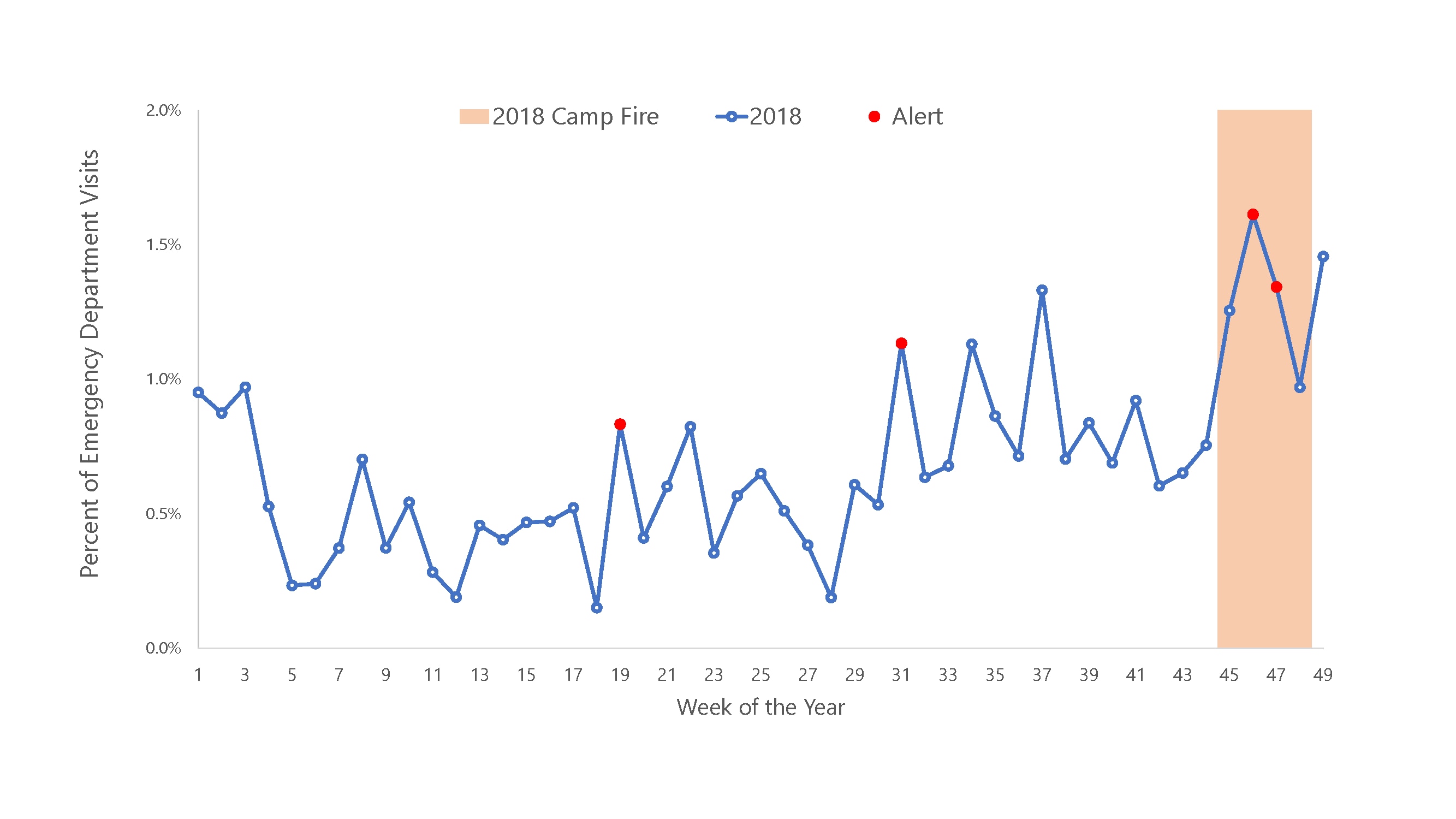
Figure. This graph overlays the percentage of Emergency Department (ED) visits due to asthma or reactive airway disease (RAD) in San Mateo County during the 2018 Camp Fire. It uses Morbidity and Mortality Weekly Report weeks, which begin with 1 for the first week of the year. Each red dot indicates an instance where the percent of ED visits due to asthma or RAD is exceptionally high. You can learn more on the CDC’s website.
As wildfires continue to threaten the public’s health across the country, agencies are demonstrating the utility, reliability, and timeliness of syndromic surveillance data for monitoring and characterizing health impacts. During the first two weeks of the 2018 Camp Fire in California, there were higher-than-expected increases in 24-hour particulate matter (PM2.5) concentrations in San Mateo County, which reached unhealthy levels. San Mateo County public health officials monitored for acute respiratory health effects and, in collaboration with the CDC National Syndromic Surveillance Program and the California Department of Public Health, they demonstrated an increase in the weekly percentage of ED visits for asthma or reactive airway disease (RAD) exacerbation, and an increase in the number of visits for smoke exposure or smoke inhalation. Among participating EDs, the county’s safety net hospital had the highest average daily percentage of ED visits for all respiratory syndromes, excluding influenza-like illness and pneumonia.
How does smoke impact firefighter health?
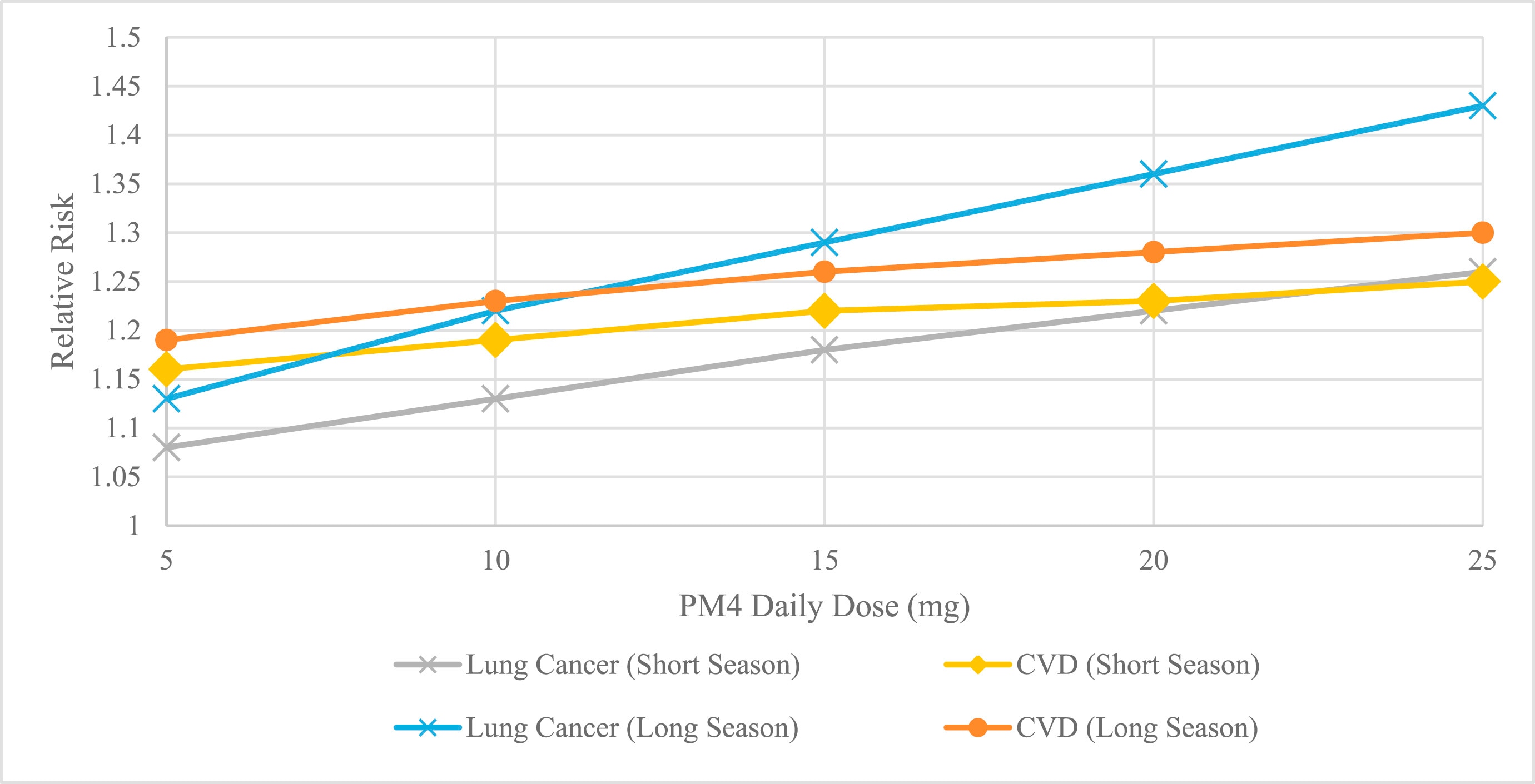
Source: Kathleen M. Navarro, Michael T. Kleinman, Chris E. Mackay, Timothy E. Reinhardt, John R. Balmes, George A. Broyles, Roger D. Ottmar, Luke P. Naher, Joseph W. Domitrovich, Wildland firefighter smoke exposure and risk of lung cancer and cardiovascular disease mortality, Environmental Research, Volume 173, 2019, Pages 462-468, ISSN 0013-9351, https://doi.org/10.1016/j.envres.2019.03.060.
One study funded by the Joint Fire Science Program found that wildland firefighters are at an increased risk for the development of lung cancer (8 percent to 43 percent above the general population) and cardiovascular disease (16 percent to 30 percent above the general population). This risk increases with an increase in career duration and days spent on wildfire incidents (short and long season) each year. The risk of lung cancer steadily rose as career length, while the risk of cardiovascular disease increased sharply for firefighters with 5- to 15-year careers and increased slightly over 20- and 25-year careers. As fire seasons continue to increase in severity and duration, firefighters should reduce exposure to smoke in any way possible.
Wildfire Smoke Can Travel Far Distances
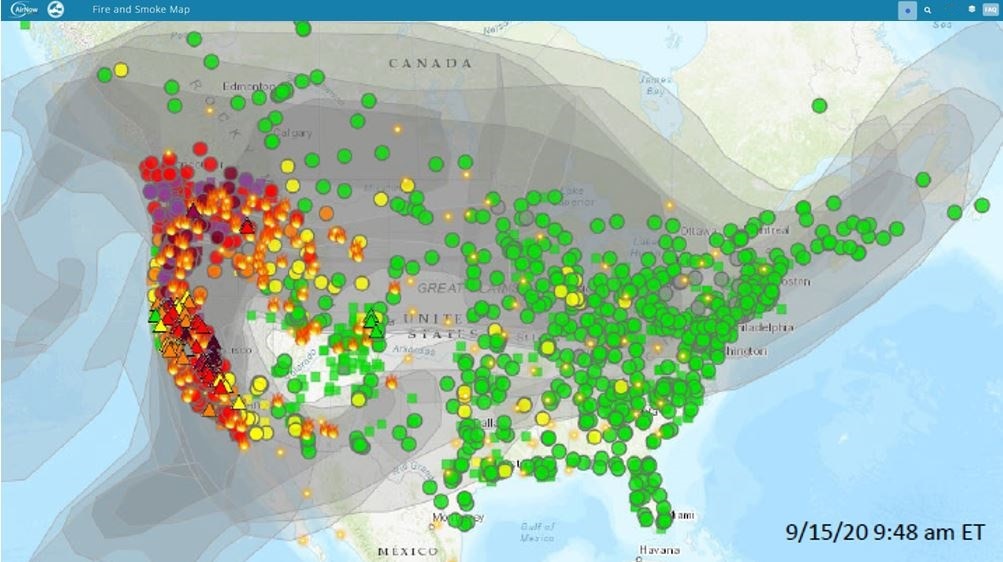
Figure: Example of the AirNow Fire and Smoke Map run by U.S. EPA and the U.S. Forest Service. This screenshot, from September 15, 2020, shows the far distances smoke can travel from the location of wildfires. The map also shows the U.S. Air Quality Index (AQI) from hundreds of air quality monitors and more than 10,000 privately owned air sensors. Green symbols indicate a good AQI; yellow indicates moderate; orange indicates unhealthy for sensitive groups; red indicates unhealthy for everyone; and purple indicates very unhealthy. The flame symbols indicate a large fire incident, and the small yellow spark symbols indicate unverified satellite fire detections.
Wildfire smoke can impact the health of people close to the fire and at distances far from fire impacted areas, depending on meteorological conditions, such as wind speed and direction. As wildfires burn, they generate smoke that is comprised of a mixture of particulate matter (PM) (also referred to as particle pollution) and gaseous pollutants (e.g., carbon monoxide). The pollutant of most concern to public health during a smoke event is fine particulate matter, or PM2.5, because these particles can penetrate deep into your lungs and cause adverse health effects.
Resources to Reduce Health Risks Associated with Wildfire
Exposure to air pollutants in wildfire smoke can irritate the lungs, cause inflammation, alter immune function, and increase susceptibility to respiratory infections, likely including COVID-19.
General Preparedness
The Ready.gov Wildfires site, Centers for Disease Control and Prevention (CDC) Wildfires site, and Environmental Protection Agency (EPA) Smoke-Ready Toolbox for Wildfires include information about how to prepare for wildfires, stay safe during a fire, and return home after a fire.
The AirNow Fire and Smoke Map, a joint project of EPA and the U.S Forest Service, provides information on fire locations, smoke plumes, and air quality, using the color-coding of the Air Quality Index (AQI), along with recommended actions to take to reduce smoke exposure. The AirNow Wildfires site provides additional information on steps to protect your health. The Map is also available in the AirNow app.
Download the Federal Emergency Management Agency (FEMA) App to receive real-time weather and emergency alerts from the National Weather Service. The App can also help you find a nearby shelter if you need to evacuate to a safe space. You can also text SHELTER and your ZIP code to 43362 (e.g. Shelter 12345) to find up to emergency shelters or FEMA Disaster Recovery Centers nearby.
The EPA and CDC continuing education program Wildfire Smoke and Your Patients’ Health can help educate healthcare professionals about the health effects of wildfire smoke and highlights actions that individuals can take to reduce exposure. This printable card contains additional information about the course.
If you do not have health insurance and are in a federally-identified disaster, the Emergency Prescription Assistance Program can help you get the prescription drugs, vaccinations, medical supplies, and equipment that they need.
If you have Medicare and your medical device is damaged or lost due to an emergency or disaster, Medicare may cover the cost to repair or replace your equipment or supplies.
You can locate and access your electronic health records from a variety of sources by using the U.S. Department of Health and Human Services' online tool.
Smoke Sense is a crowdsourcing, participatory science research project developed by EPA researchers focused on increasing public awareness and engagement related to wildfire smoke health risks.
Protecting Vulnerable Populations from Wildfire Smoke
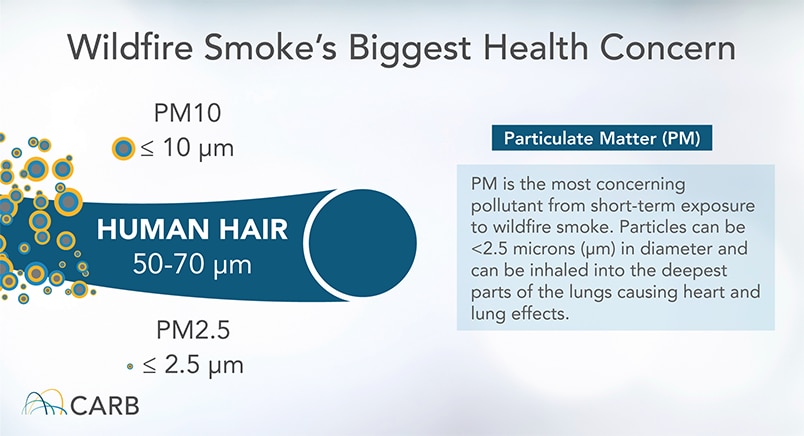
Image source: https://ww2.arb.ca.gov/protecting-yourself-wildfire-smoke
Pregnant people should take actions to reduce their exposure to wildfire smoke, which could affect the developing fetus. Other groups like young children, the elderly, those with pre-existing heart and lung disease, and outdoor workers also should take extra care to reduce their exposures to wildfire smoke. Monitor fires and air quality in your area through AirNow and follow instructions about exercise and going outside for "sensitive individuals."
Additional steps you can take to prepare include stocking up on medicine and buying groceries that don’t need to be cooked. In particular, frying or grilling food can make indoor air pollution worse. More information is available on the CDC website for people with chronic conditions, pregnant people, and children.
The California Air Resources Board Air Cleaner Information for Consumers has information about how to select a safe and effective air cleaner. Exercise caution in using air-cleaning devices in the home; some can produce ozone levels that are higher than health-based standards. The Environmental Protection Agency (EPA) also has information on how to Create a Clean Room to Protect Indoor Air Quality During a Wildfire and the California Air Resources Board has information on Protecting Yourself from Wildfire Smoke.
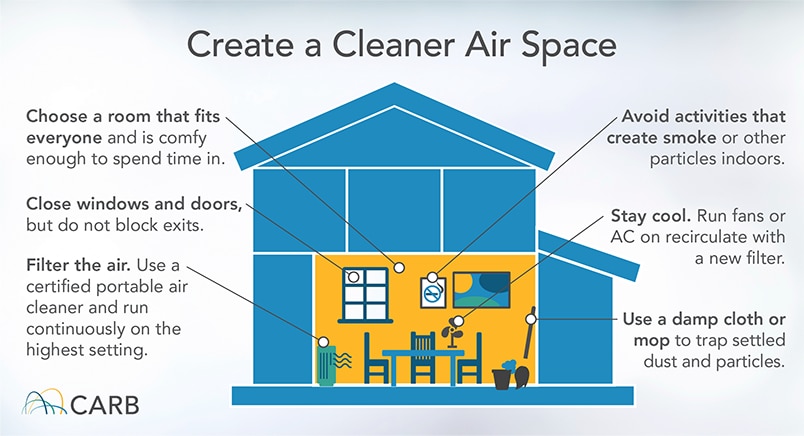
Image source: https://ww2.arb.ca.gov/protecting-yourself-wildfire-smoke
Mental Health
Feelings such as overwhelming anxiety, constant worrying, trouble sleeping, and other depression-like symptoms are common responses before, during, and after wildfires. The Substance Abuse and Mental Health Services Administration (SAMHSA) Helpline and Text Service is available 24/7, free, and staffed by trained crisis counselors. Call or text 1-800-985-5990 to get help and support for any distress that you or someone you care about may be feeling related to any disaster.
Learn more about wildfires and mental health at the SAMHSA’s Wildfires site. SAMHSA also has other disaster behavioral health resources, including resources specifically about wildfires and their impacts on mental health. The CDC also has resources in English and Spanish on Coping with a Disaster or Traumatic Event.
Check out SAMHSA’s newly launched Climate Change and Health Equity site for more information on the behavioral health impacts of climate change, preparing for a disaster, and resources for disaster planning and climate change education.
Best Practices for Emergency Managers
The Office of the Assistant Secretary for Preparedness and Response Technical Resources, Assistance Center, and Information Exchange (ASPR TRACIE) has collected lessons learned on Wildfires. An HHS emPOWER Program Story from the Field on Wildfires in Los Angeles County, California briefly explains how HHS emPOWER tools were used to rapidly conduct outreach to nearly 40 durable medical equipment (DME) and oxygen suppliers to provide recovery assistance to more than 600 individuals impacted by the historic 2017 wildfires.
Smoke-Ready Communities is an EPA and U.S. Forest Service Collaboration that is built around a series of interactive workshops and is designed to increase local readiness and improved public health response to wildfire smoke events.
Wildfire Smoke: A Guide for Public Health Officials -- the product of an inter-agency collaboration that includes the California Air Resources Board; California Office of Environmental Health Hazard Assessment; CDC; U.S. Forest Service; and EPA -- is designed to help local public health officials prepare for smoke events, to take measures to protect the public when smoke is present, and communicate with the public about wildfire smoke and health.
The CDC produced a summary for health departments on Evidence on the Use of Indoor Air Filtration as an Intervention for Wildfire Smoke Pollutant Exposure. For commercial buildings, the ASHRAE Planning Framework for Protecting Commercial Building Occupants from Smoke During Wildfire Events provides recommended heating, ventilation, and air conditioning (HVAC) and building measures to minimize occupant exposures and health impacts from smoke.
Workers face hazards even after fires are extinguished. The CDC’s Worker Safety During Fire Cleanup Fact Sheet reviews potential dangers during post-wildfire cleanup.
The HHS emPOWER collects and shares de-identified Medicare data to help response agencies take action to protect the health of Medicare beneficiaries who depend on vulnerable electrical medical equipment.
Resources for Wildland Fire Fighters
Wildland fire presents unique challenges and fire fighters must understand how to best protect their health and safety while fighting fires. Wildland Fire Fighting: Hot Tips to Stay Safe and Healthy reviews some recommended practices for fire fighters and their supervisors. Wildland Firefighter Health: Some Burning Questions offers information on hazards and risks associated with the wildland firefighting job.
Wildland fire fighting involves exposure to heat and prolonged, intense exertion. These factors increase the risk for rhabdomyolysis. The CDC Rhabdomyolysis site has additional information, factsheets, and wallet cards.

